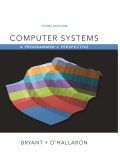
Concept explainers
A.
IP addresses:
- The IP address denotes an unsigned integer that is 32-bit.
- The IP addresses is been stored by network programs in IP address structure.
- The addresses present in IP address structure are stored in network byte order.
- An unsigned 32-bit integer is transformed from host byte order to network byte order by “htonl” function.
- An unsigned 32-bit integer is transformed from network byte order host byte order by “ntohl” function.
- The IP address is presented to humans in a form known as “dotted-decimal” notation.
- Each byte is been represented by its corresponding decimal value and is separated by a period from other bytes.
Passing
- The arguments for “GET” requests are passed in the URI.
- The character “?” separates filename from the arguments.
- The character “&” separates each argument.
- The arguments do not allow spaces in it.
Server passes arguments to child:
- The server calls “fork” to create a child process and calls “execve” to run program in child’s context once it receives a request.
- The child process sets CGI environment variable values.
- The “adder” program can reference it at run time using “getenv” function of linux.
Output is sent by child:
- The dynamic content of a CGI program is to be sent to standard output.
- A CGI program sends dynamic content to standard output.
- It uses “dup2” function for redirecting standard output to connected descriptor associated with client.
- The result written to standard output by CGI program, it goes directly to client.
A.
Explanation of Solution
Modified C code:
//Define method
void clienterror(int fd, char *cause, char *errnum, char *shortmsg, char *longmsg);
//Define method
void echo(int connfd);
//Define main method
int main(int argc, char **argv)
{
//Declare variables
int listenfd, connfd;
//Call method
Getnameinfo((SA *) &clientaddr, clientlen, hostname, MAXLINE,port, MAXLINE, 0);
//Display message
printf("Accepted connection from (%s, %s)\n", hostname, port);
//Call method
echo(connfd);
//Close
Close(connfd);
}
//Define method
void echo(int connfd)
{
//Declare variable
size_t n;
//Declare array
char buf[MAXLINE];
//Declare variable
rio_t rio;
//Call method
Rio_readinitb(&rio, connfd);
//Loop
while ((n = Rio_readlineb(&rio, buf, MAXLINE)) != 0)
{
//If condition satisfies
if (strcmp(buf, "\r\n") == 0)
//Break
break;
//Call method
Rio_writen(connfd, buf, n);
}
}
Explanation:
- The method “echo” declares the variables first.
- It handles one HTTP response/request transaction.
- The value is been read using method “readinitb” and is stored.
- The value is been written into buffer using “written” method.
- The comparison is made until new line occurs.
B.
IP addresses:
- The IP address denotes an unsigned integer that is 32-bit.
- The IP addresses is been stored by network programs in IP address structure.
- The addresses present in IP address structure are stored in network byte order.
- An unsigned 32-bit integer is converted from host byte order to network byte order by “htonl” function.
- An unsigned 32-bit integer is converted from network byte order host byte order by “ntohl” function.
- The IP address is presented to humans in a form known as “dotted-decimal” notation.
- Each byte is been represented by its corresponding decimal value and is separated by a period from other bytes.
Passing program arguments to server:
- The arguments for “GET” requests are passed in the URI.
- The character “?” separates filename from the arguments.
- The character “&” separates each argument.
- The arguments do not allow spaces in it.
Server passes arguments to child:
- The server calls “fork” to create a child process and calls “execve” to run program in child’s context once it receives a request.
- The child process sets CGI environment variable values.
- The “adder” program can reference it at run time using “getenv” function of linux.
Output is sent by child:
- The dynamic content of a CGI program is to be sent to standard output.
- A CGI program sends dynamic content to standard output.
- It uses “dup2” function for redirecting standard output to connected descriptor associated with client.
- The result written to standard output by CGI program, it goes directly to client.
B.
Explanation of Solution
Request to TINY for static content:
GET / HTTP/1.1
Host: localhost:5000
User-Agent: Mozilla/5.0 (X11; Ubuntu; Linux x86_64; rv:53.0) Gecko/20100101 Firefox/53.0
Accept: text/html,application/xhtml+xml,application/xml;q=0.9,*/*;q=0.8
Accept-Language: en-US,en;q=0.5
Accept-Encoding: gzip, deflate
Connection: keep-alive
Explanation:
- The given code denotes a request to “TINY” for static content.
- It echoes each and every request line.
- It echoes each and every request header.
- It takes a particular “Accept-Language” and “Accept-Encoding” for the content.
C.
IP addresses:
- The IP address denotes an unsigned integer that is 32-bit.
- The IP addresses is been stored by network programs in IP address structure.
- The addresses present in IP address structure are stored in network byte order.
- An unsigned 32-bit integer is converted from host byte order to network byte order by “htonl” function.
- An unsigned 32-bit integer is converted from network byte order host byte order by “ntohl” function.
- The IP address is presented to humans in a form known as “dotted-decimal” notation.
- Each byte is been represented by its corresponding decimal value and is separated by a period from other bytes.
Passing program arguments to server:
- The arguments for “GET” requests are passed in the URI.
- The character “?” separates filename from the arguments.
- The character “&” separates each argument.
- The arguments do not allow spaces in it.
Server passes arguments to child:
- The server calls “fork” to create a child process and calls “execve” to run program in child’s context once it receives a request.
- The child process sets CGI environment variable values.
- The “adder” program can reference it at run time using “getenv” function of linux.
Output is sent by child:
- The dynamic content of a CGI program is to be sent to standard output.
- A CGI program sends dynamic content to standard output.
- It uses “dup2” function for redirecting standard output to connected descriptor associated with client.
- The result written to standard output by CGI program, it goes directly to client.
C.
Explanation of Solution
Version of HTTP:
- The version of HTTP used by browser is HTTP 1.1.
- The output from “TINY” is been inspected for determining HTTP version of browser.
- The “TINY” denotes an iterative server that listens for connection requests on ports.
- The “TINY” executes infinite server loop; it accepts a connection request repeatedly.
- It performs the transaction and closes its end of connection.
- Hence, version of HTTP is “HTTP 1.1”.
D.
IP addresses:
- The IP address denotes an unsigned integer that is 32-bit.
- The IP addresses is been stored by network programs in IP address structure.
- The addresses present in IP address structure are stored in network byte order.
- An unsigned 32-bit integer is converted from host byte order to network byte order by “htonl” function.
- An unsigned 32-bit integer is converted from network byte order host byte order by “ntohl” function.
- The IP address is presented to humans in a form known as “dotted-decimal” notation.
- Each byte is been represented by its corresponding decimal value and is separated by a period from other bytes.
Passing program arguments to server:
- The arguments for “GET” requests are passed in the URI.
- The character “?” separates filename from the arguments.
- The character “&” separates each argument.
- The arguments do not allow spaces in it.
Server passes arguments to child:
- The server calls “fork” to create a child process and calls “execve” to run program in child’s context once it receives a request.
- The child process sets CGI environment variable values.
- The “adder” program can reference it at run time using “getenv” function of linux.
Output is sent by child:
- The dynamic content of a CGI program is to be sent to standard output.
- A CGI program sends dynamic content to standard output.
- It uses “dup2” function for redirecting standard output to connected descriptor associated with client.
- The result written to standard output by CGI program, it goes directly to client.
D.
Explanation of Solution
Meaning of HTTP headers:
- The details of each HTTP header is shown below:
- Accept:14.1:
- It can be used for specifying certain media types that are acceptable for response.
- Accept headers are used to indicate that request is limited specifically to a small set of desired types.
- It has same impact as in case of an in-line image request.
- Accept-Encoding: 14.3:
- The request header field is almost similar to “Accept”.
- It restricts the content-coding that are acceptable in response.
- Accept-Language: 14.4:
- The “Accept-Language” request header is similar to that of “Accept”.
- It restricts set of natural languages preferred as response to request.
- Connection: 14.10:
- The connection header field allows sender to specify options that are desired for particular connection.
- It must not be communicated by proxies over further connections.
- Host: 14.23:
- The host request header field would specify internet host and port number of resource being requested.
- The host field value denotes origin server’s naming authority or gateway given by original URL.
- It allows origin server or gateway in differentiating between ambiguous URLs.
- The root “/” server’s URL is used for multiple host names with single IP address.
- User-Agent: 14.43:
- The user-agent request header has information about user agent initiating the request.
- It is used for tracing protocol violations, automated acknowledgment of user agents for avoiding limitations of user agent.
- The requests are been added with the field.
- The field contains multiple product tokens and comments that identifies agent.
- It includes sub products that forms a significant part of user agent.
- The product tokens are listed in order of their significance for application identification.
- Accept:14.1:
Want to see more full solutions like this?
Chapter 11 Solutions
EBK COMPUTER SYSTEMS
 A+ Guide To It Technical SupportComputer ScienceISBN:9780357108291Author:ANDREWS, Jean.Publisher:Cengage,
A+ Guide To It Technical SupportComputer ScienceISBN:9780357108291Author:ANDREWS, Jean.Publisher:Cengage, EBK JAVA PROGRAMMINGComputer ScienceISBN:9781337671385Author:FARRELLPublisher:CENGAGE LEARNING - CONSIGNMENTNp Ms Office 365/Excel 2016 I NtermedComputer ScienceISBN:9781337508841Author:CareyPublisher:Cengage
EBK JAVA PROGRAMMINGComputer ScienceISBN:9781337671385Author:FARRELLPublisher:CENGAGE LEARNING - CONSIGNMENTNp Ms Office 365/Excel 2016 I NtermedComputer ScienceISBN:9781337508841Author:CareyPublisher:Cengage New Perspectives on HTML5, CSS3, and JavaScriptComputer ScienceISBN:9781305503922Author:Patrick M. CareyPublisher:Cengage Learning
New Perspectives on HTML5, CSS3, and JavaScriptComputer ScienceISBN:9781305503922Author:Patrick M. CareyPublisher:Cengage Learning LINUX+ AND LPIC-1 GDE.TO LINUX CERTIF.Computer ScienceISBN:9781337569798Author:ECKERTPublisher:CENGAGE L
LINUX+ AND LPIC-1 GDE.TO LINUX CERTIF.Computer ScienceISBN:9781337569798Author:ECKERTPublisher:CENGAGE L





